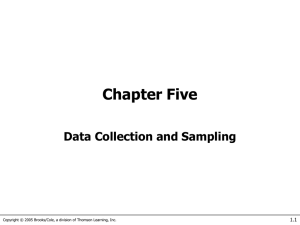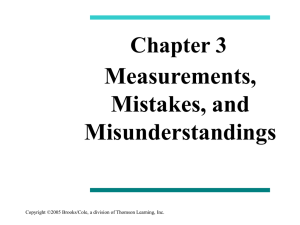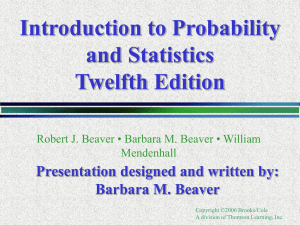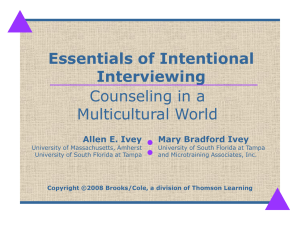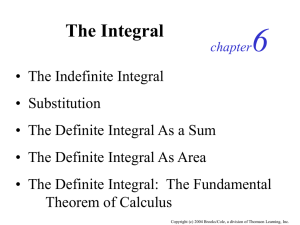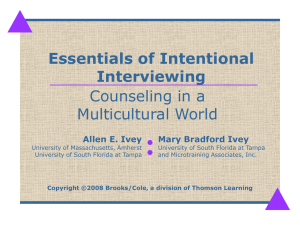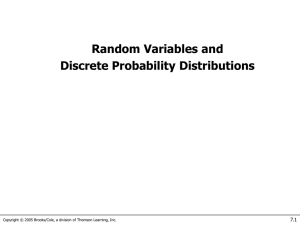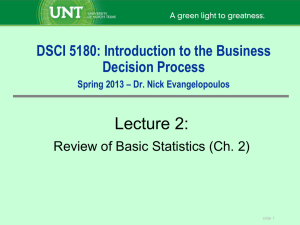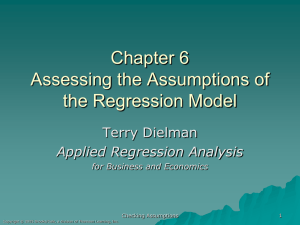PPT Chapter 9 – Sampling Distributions
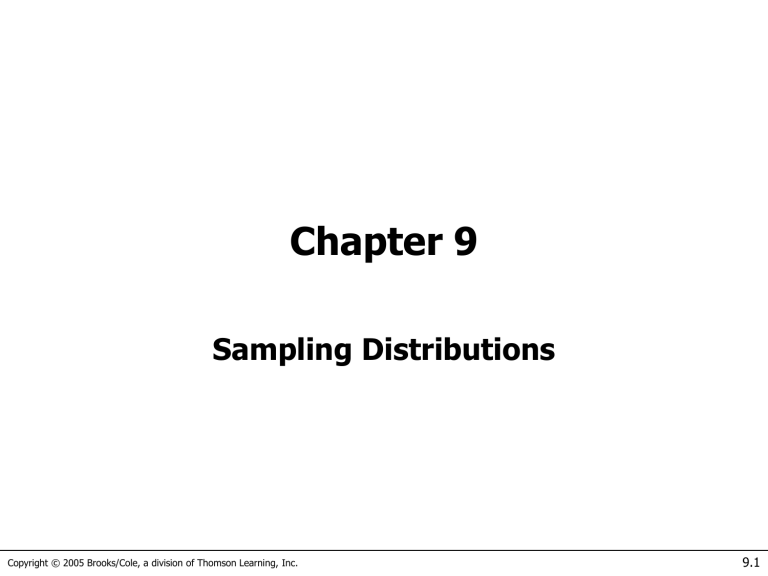
Chapter 9
Sampling Distributions
Copyright © 2005 Brooks/Cole, a division of Thomson Learning, Inc.
9.1
Sampling Distributions…
A sampling distribution is created by, as the name suggests, sampling .
The method we will employ on the rules of probability and the laws of expected value and variance to derive the sampling distribution.
For example, consider the roll of one and two dice…
9.2
Copyright © 2005 Brooks/Cole, a division of Thomson Learning, Inc.
Sampling Distribution of the Mean…
A fair die is thrown infinitely many times, with the random variable X = # of spots on any throw.
The probability distribution of X is: x 1 2 3 4 5 6
P(x) 1/6 1/6 1/6 1/6 1/6 1/6
…and the mean and variance are calculated as well:
Copyright © 2005 Brooks/Cole, a division of Thomson Learning, Inc.
9.3
Sampling Distribution of Two Dice
A sampling distribution is created by looking at all samples of size n=2 (i.e. two dice) and their means…
While there are 36 possible samples of size 2, there are only
11 values for , and some (e.g. =3.5) occur more frequently than others (e.g. =1).
Copyright © 2005 Brooks/Cole, a division of Thomson Learning, Inc.
9.4
Sampling Distribution of Two Dice…
The sampling distribution of is shown below:
1.0
1.5
2.0
2.5
3.0
3.5
4.0
4.5
5.0
5.5
6.0
P( )
1/36
2/36
3/36
4/36
5/36
6/36
5/36
4/36
3/36
2/36
1/36
6/36
5/36
4/36
3/36
2/36
1/36
1.0
1.5
2.0
2.5
3.0
3.5
4.0
4.5
5.0
5.5
6.0
Copyright © 2005 Brooks/Cole, a division of Thomson Learning, Inc.
9.5
Compare…
Compare the distribution of X…
2 3 4 5 6 1.0
1.5
2.0
2.5
3.0
3.5
4.0
4.5
5.0
5.5
6.0
1
…with the sampling distribution of .
As well, note that:
Copyright © 2005 Brooks/Cole, a division of Thomson Learning, Inc.
9.6
Generalize…
We can generalize the mean and variance of the sampling of two dice:
…to n -dice:
The standard deviation of the sampling distribution is called the standard error :
Copyright © 2005 Brooks/Cole, a division of Thomson Learning, Inc.
9.7
Central Limit Theorem…
The sampling distribution of the mean of a random sample drawn from any population is approximately normal for a sufficiently large sample size .
The larger the sample size, the more closely the sampling distribution of X will resemble a normal distribution.
Copyright © 2005 Brooks/Cole, a division of Thomson Learning, Inc.
9.8
Central Limit Theorem… [Most important theorem in statistics]
The sampling distribution of the sample mean will be approximately normal as the sample size increases.
In many practical situations, a sample size of 30 [population needs to be what I call well behaved – sort of mounded but may be shewed] may be sufficiently large to allow us to use the normal distribution as an approximation for the sampling distribution of X.
Note: If X is normal, X is normal. Don’t need Central Limit
Theorem in this case.
Copyright © 2005 Brooks/Cole, a division of Thomson Learning, Inc.
9.9
Example 9.1(a)…
The foreman of a bottling plant has observed that the amount of soda in each “32-ounce” bottle is actually a normally distributed random variable, with a mean of 32.2 ounces and a standard deviation of .3 ounce.
If a customer buys one bottle, what is the probability that the bottle will contain more than 32 ounces?
Regular old look up a normal probability.
9.10
Copyright © 2005 Brooks/Cole, a division of Thomson Learning, Inc.
Example 9.1(a)…
We want to find P(X > 32), where X is normally distributed and =32.2 and =.3
“there is about a 75% chance that a single bottle of soda contains more than 32oz.”
Copyright © 2005 Brooks/Cole, a division of Thomson Learning, Inc.
9.11
Example 9.1(b)…
The foreman of a bottling plant has observed that the amount of soda in each “32-ounce” bottle is actually a normally distributed random variable, with a mean of 32.2 ounces and a standard deviation of .3 ounce.
If a customer buys a carton of four bottles, what is the probability that the mean amount of the four bottles will be greater than 32 ounces?
9.12
Copyright © 2005 Brooks/Cole, a division of Thomson Learning, Inc.
Example 9.1(b)…
We want to find P(X > 32), where X is normally distributed with =32.2 and =.3
Things we know:
1) X is normally distributed, therefore so will X.
2) = 32.2 oz.
3)
9.13
Copyright © 2005 Brooks/Cole, a division of Thomson Learning, Inc.
Example 9.1(b)…
If a customer buys a carton of four bottles, what is the probability that the mean amount of the four bottles will be greater than 32 ounces?
“There is about a 91% chance the mean of the four bottles will exceed 32oz.”
Copyright © 2005 Brooks/Cole, a division of Thomson Learning, Inc.
9.14
Graphically Speaking…
mean=32.2
what is the probability that one bottle will contain more than 32 ounces?
what is the probability that the mean of four bottles will exceed 32 oz?
9.15
Copyright © 2005 Brooks/Cole, a division of Thomson Learning, Inc.
Chapter-Opening Example…
The dean of the School of Business claims that the average salary of the school’s graduates one year after graduation is $800 per week ( standard deviation of $100 (σ x
μ x
) with a
) . Note:
This is the population. A second-year student would like to check whether the claim about the mean is correct. He does a survey of 25 people who graduated one year ago and determines their weekly salary. He discovers the sample mean to be $750 . Is this consistent with the dean’s claim???
x
800
x
/ n
100 / 25
20
9.16
Copyright © 2005 Brooks/Cole, a division of Thomson Learning, Inc.
Sampling Distribution of a Proportion…
The estimator of a population proportion of successes is the sample proportion . That is, we count the number of successes in a sample and compute:
(read this as “p-hat”).
X is the number of successes, n is the sample size.
Copyright © 2005 Brooks/Cole, a division of Thomson Learning, Inc.
9.17
Normal Approximation to Binomial…
Binomial distribution with n=20 and p=.5 with a normal approximation superimposed ( =10 and =2.24)
Copyright © 2005 Brooks/Cole, a division of Thomson Learning, Inc.
9.18
Normal Approximation to Binomial…
Binomial distribution with n=20 and p=.5 with a normal approximation superimposed ( =10 and =2.24) where did these values come from?!
From §7.6 we saw that:
Hence:
Copyright © 2005 Brooks/Cole, a division of Thomson Learning, Inc.
and
9.19
Normal Approximation to Binomial…
Normal approximation to the binomial works best when the number of experiments, n, (sample size) is large, and the probability of success, p, is close to 0.5
For the approximation to provide good results two conditions should be met:
1) np ≥ 5
2) n(1–p) ≥ 5
9.20
Copyright © 2005 Brooks/Cole, a division of Thomson Learning, Inc.
Sampling Distribution of a Sample Proportion…
Using the laws of expected value and variance, we can determine the mean, variance, and standard deviation of .
(The standard deviation of is called the standard error of the proportion .)
Sample proportions can be standardized to a standard normal distribution using this formulation:
Copyright © 2005 Brooks/Cole, a division of Thomson Learning, Inc.
9.21
Sampling Distribution:
Difference of two means
The final sampling distribution introduced is that of the difference between two sample means . This requires:
independent random samples be drawn from each of two normal populations
If this condition is met, then the sampling distribution of the difference between the two sample means will be normally distributed if the populations are both normal.
(note: if the two populations are not both normally distributed, but the sample sizes are “large” (>30), the distribution of is approximately normal) – Central
Limit Theorem
9.22
Copyright © 2005 Brooks/Cole, a division of Thomson Learning, Inc.
Sampling Distribution:
Difference of two means is normally distributed with mean: and standard deviation:
(also called the standard error of the difference between two means)
9.23
Copyright © 2005 Brooks/Cole, a division of Thomson Learning, Inc.
Example 9.3…
Starting salaries for MBA grads at two universities are normally distributed with the following means and standard deviations. Samples from each school are taken…
Mean
Std. Dev.
sample size n
University 1
62,000 $/yr
14,500 $/yr
50
University 2
60,000 $/yr
18,300 $/yr
60
What is the sampling distribution of
Copyright © 2005 Brooks/Cole, a division of Thomson Learning, Inc.
9.24
Sampling Distribution is normally distributed with mean: = 62,999 – 60,000 = 2000 and standard deviation:
=SQRT(14,500 2 /50 + 18,300 2 /60)
= 3128.3
Copyright © 2005 Brooks/Cole, a division of Thomson Learning, Inc.
9.25
